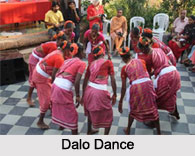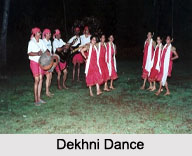 The folk dances of Goa bear a tradition of thousands of years, characterized by innumerable forms performed by and reflecting lifestyles, cultures and aspirations of different strata, religions and castes of Goan society. The prominent ones include the Dashavatara, Ghode Modni and the Goff Dance. Goa is also referred as the ‘Rome of East’ is one of the most phenomenon and contemporary tourist destination in India with tradition Goan culture and folklore. Colonized by Portuguese for 450 years, cultural tradition of Goa consists of numerous Goa churches, temples and mosques.
The folk dances of Goa bear a tradition of thousands of years, characterized by innumerable forms performed by and reflecting lifestyles, cultures and aspirations of different strata, religions and castes of Goan society. The prominent ones include the Dashavatara, Ghode Modni and the Goff Dance. Goa is also referred as the ‘Rome of East’ is one of the most phenomenon and contemporary tourist destination in India with tradition Goan culture and folklore. Colonized by Portuguese for 450 years, cultural tradition of Goa consists of numerous Goa churches, temples and mosques.Some of the popular folk dances of Goa are as follows:
The Dalo: The Dalo is an earliest Goan folk dance completed mainly by women which combines dance, drama and music. Women dressed in multi-coloured traditional saris stand in two rows, facing each other and dance to the tune of musical folk songs. Previously the crop is cut and stored, the dalo is held at the village maand (sacred ground) on moonlit nights in winter (in the Hindu month of paush).

Diwli Nach: Diwli Nach is a dance performed in shigmo whilst balancing an oil-lamp with five light wicks on the head with no any support. The trick is not to lean or collapse the lamp during the dance. Though a great amount of attention is required to perform this job, the dancers go about it very naturally and elegantly.
Ghode Modni: It is a fighting dance performed in North Goa. The dance is held in shigmo by men flourishing swords and tiring a favourite subject who gives them the look of riding horses. The dance is said to portray the winning returning home of Rane’s warriors after defeating the opponent. The costumes are worn after carrying out spiritual rituals, typically in a temple.
Goff: It is also performed during the shigmo celebration. In the village of Poiguinim, a group of men move from house to house performing this dance. Bright ropes are suspended from the roof of the matov (canopy). Each dancer holds one rope and to the rhythm of the song, performs the dance twining the ropes in the procedure to form a cord. Then they do reverse movements to untwine the ropes.
Mando: Mando is a folk song where men and women replicate a mock flirtation to songs that speak expressively of desire and rejections of love. The mando is sung by the Christians in family celebrations like weddings and feasts. The western influenced melodies are played on a violin, while a ghumot (local percussion instrument) provides the hit.
Dekhni Dance: Dekhni is referred as a song cum dance. This is as the song has western bearings while the dance is of Indian form. It is only the women dancers who carry out this beautiful dance. A film producer got so enchanted by a popular Dekhni song that he made it well-known to every child of the country. Whenever this dance is performed, it is done with ghumat.
For more, visit the link below: